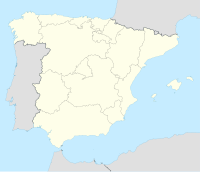Santiago de Peñalba
Santiago de Peñalba |
The former abbey church of Santiago de Peñalba in Peñalba de Santiago , a small town in the province of León in the autonomous Spanish region of Castile and León , was built in the 10th century. It is located at almost 1,100 meters in a remote high valley of the Montes de León mountain range , about 20 km south of Ponferrada , the capital of the Comarca El Bierzo . The name Peñalba means white rock and refers to a striking limestone massif . In addition to San Miguel de Escalada , San Cebrián de Mazote , Santa María de Lebeña and San Miguel de Celanova, the Church of Santiago de Peñalba is one of the most important Mozarabic buildings in northwest Spain. The construction of the church is dated from 931 to 937.
history
The monastery, consecrated to the Apostle James , was built in the early 10th century by St. Gennadius founded. He became bishop of Astorga in 909 . In 920 he gave up his office to retreat to Peñalba in a lonely high valley of the Montes de León, where he led the life of a hermit and died in 936. His bones were buried in the west apse of the church until they were reburied in Villafranca del Bierzo in the 16th century . In Peñalba there was both a community of monks and isolated hermits in the area . The monastery was abandoned as early as the 13th century and the church was used as a parish church by the small community that had settled around the monastery . It wasn't until the beginning of the 20th century that people began to be interested in the Church again. In 1931 it was declared a Monumento Histórico-Artístico Nacional ( Bien de Interés Cultural ). The first restoration work was initiated in the 1940s.

architecture
The church is made of quarry stone ( slate and limestone ). Four narrow window openings are still original. Fragments of the original stone transenne ( celosía ) have been preserved on the west facade . The roof is covered with slate. Under the roof are small stone cantilever consoles , which - as in San Miguel de Escalada - refer to Mozarab builders and the Mezquita de Córdoba as a model. The open bell gable (espadaña), a later addition, stands separately, west of the church.
There are two entrances to the church. The south portal has a double, closely closed horseshoe arch with an Alfiz frame , which is typical of Mozarabic architecture . How these two sheets are very carefully hewn inside limestone wedges formed and the columns have Corinthian marble capitals and three-level fighters with Perlstabverzierung .
inner space
The plan of the church is a Latin cross . At the location of the nave , two squares, the lay choir and the choir square , follow one another, which open into an apse in both the east and west . Both apses have a horseshoe-shaped floor plan, with the horseshoe arch of the eastern apse being much more tightly closed than the arch of the western opposite apse. On the outside, both vestibules have a right-angled casing. On both sides of the choir square, like the arms of a transept , are joined by two rooms that are also interpreted as sacristies . Inaccessible chambers ( cámara oculta ) have been discovered above its barrel vault as above the apses . These chambers without any access from the outside are u. a. also in San Baudelio de Berlanga , San Salvador de Valdediós or San Miguel de Escalada . Their meaning, however, has not been clarified.
The four inner areas (east and west apse and the two squares) are connected by horseshoe arches made of regular wedge stones. They rest on narrow, reused columns with Corinthian capitals on which - as in the portico of San Miguel de Escalada - three-tier warriors with pearl rods rest. The arch to the east or altar apse is framed by an Alfiz bar. The apses and the choir square have eight-part umbrella domes . On the walls and vaults there are still frescoes from the time the church was built.
literature
- Achim Arbeiter , Sabine Noack-Haley: Christian monuments of the early Middle Ages from the 8th to the 11th century . Mainz 1999, ISBN 3-8053-2312-3 , pp. 295-301, 311-313.
- Jaime Cobreros: Guía del Prerrománico en España . Madrid 2006, ISBN 84-9776-215-0 , pp. 145-148.
- Jacques Fontaine: L'Art Mozarabe. L'Art Préroman Hispanique . Vol. 2, Éditions Zodiaque, La Pierre-qui-Vire 2nd edition 1995, ISBN 2-7369-0215-7 , pp. 141-147.
Web links
Coordinates: 42 ° 25 ′ 38 ″ N , 6 ° 32 ′ 27 ″ W.



